Review: Olight M3XS-UT Javelot – Super Thrower (3/4xCR123, 2x18650)
Olight have been building up performance levels with the other Javelot models. These Javelots have been getting noticed for their enhanced throw, and then Olight released the M3XS-UT taking performance up another notch. The M3XS-UT is currently the top of performer amongst the Javelots.
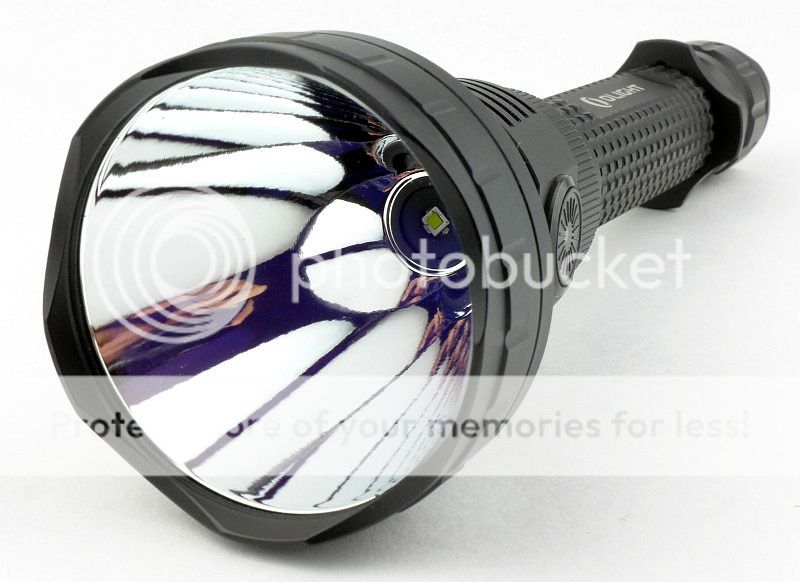
Taking a more detailed look:
Like all the Javelots I've tested, the M3XS-UT comes with a plastic carry case rather than a disposable cardboard box.
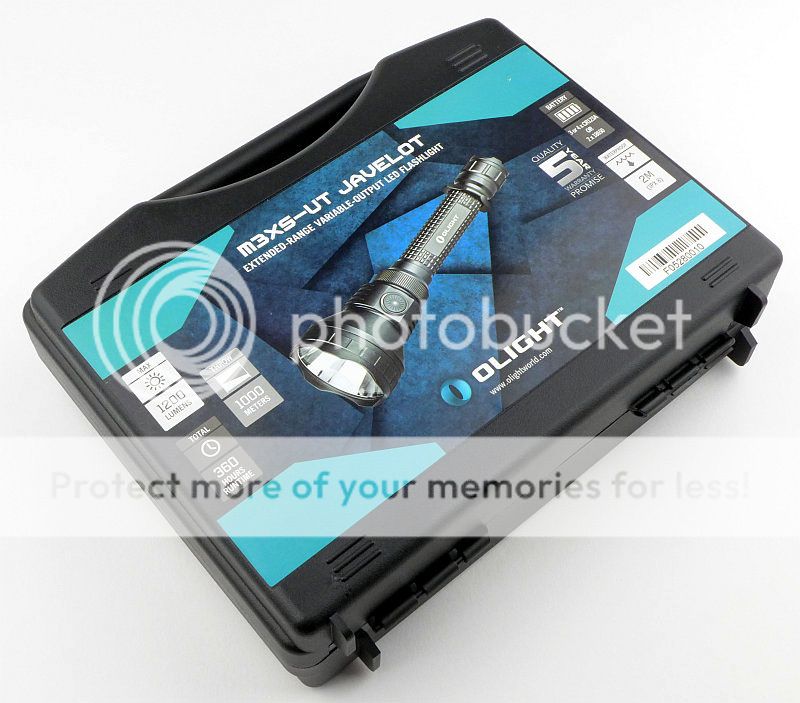
Inside, the contents are held in place with a foam liner. The empty slot would contain the CR123 holder, but in this case this demonstration light had a set of cells fitted into the light when it arrived.
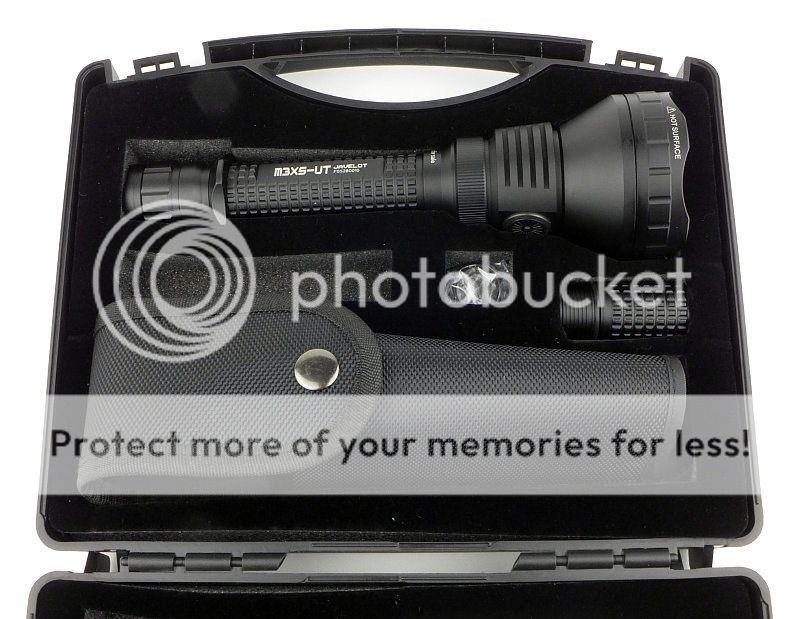
Included are the M3XS-UT, an extender tube, holster, two O-rings and the instructions. (the CR123 cell holder is already in the light here).
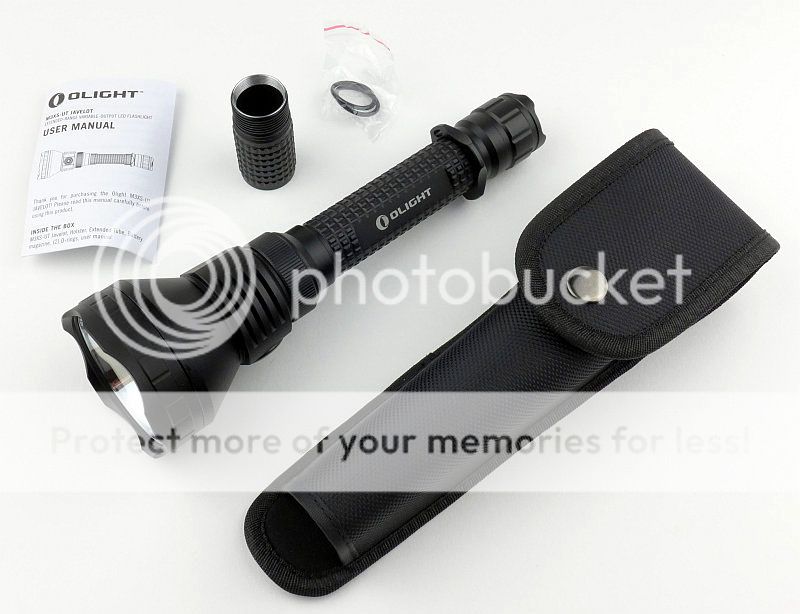
Out of necessity, the M3XS-UT has an open bottom holster.

You have the choice of D-ring or Velcro-closed belt loop.
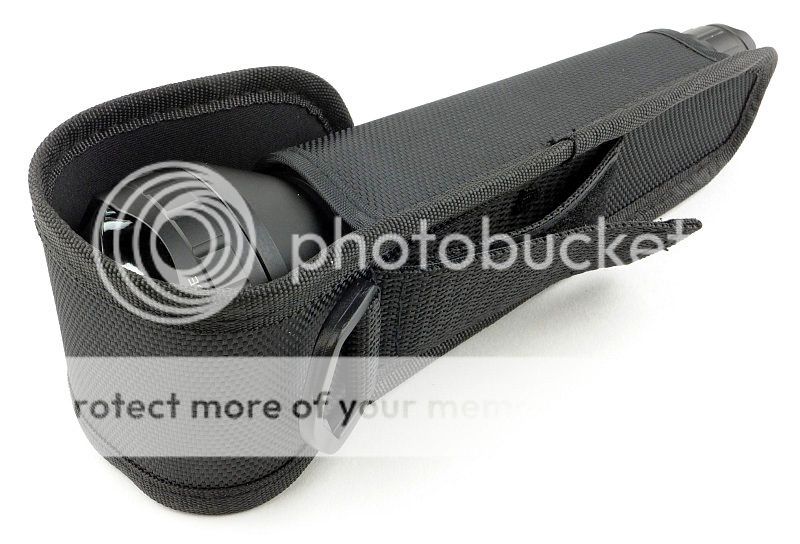
This is why there is an open bottom in the holster.
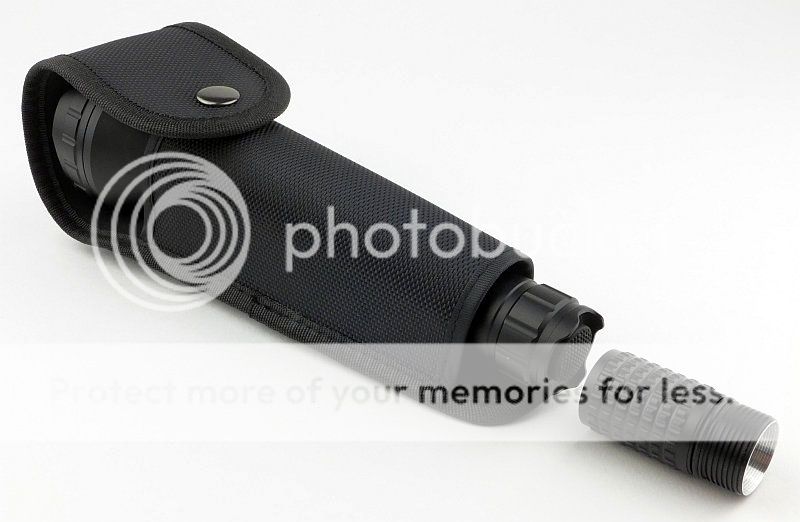
This holster can be used with or without the extension tube.
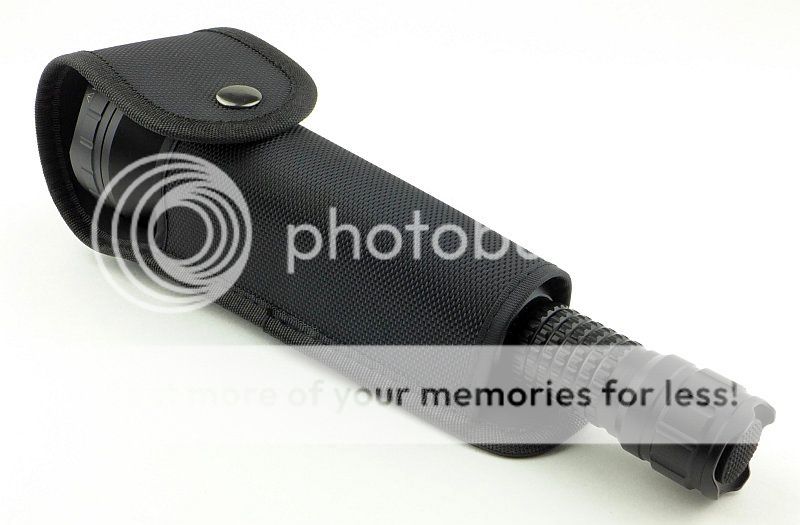
The M3SX-UT has a removable grip ring.
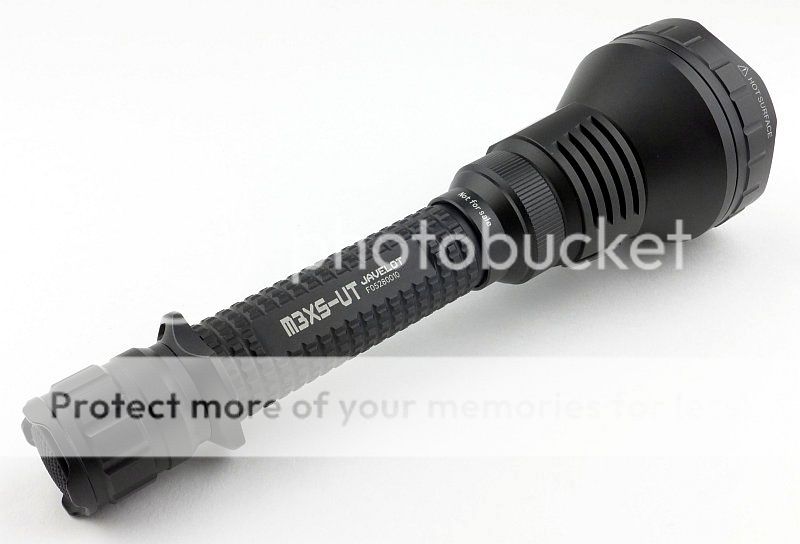
Instead of standard knurling a very effective pattern is machined into the body.
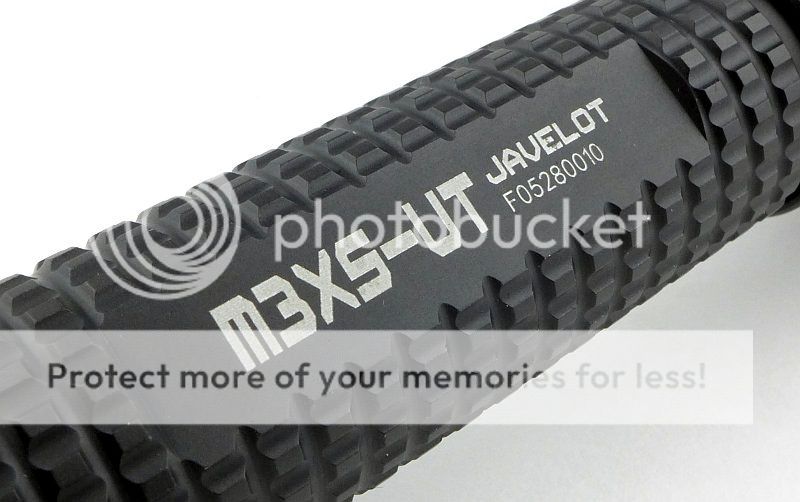
In addition to the tail-cap switch, there is a side-switch for mode selection.
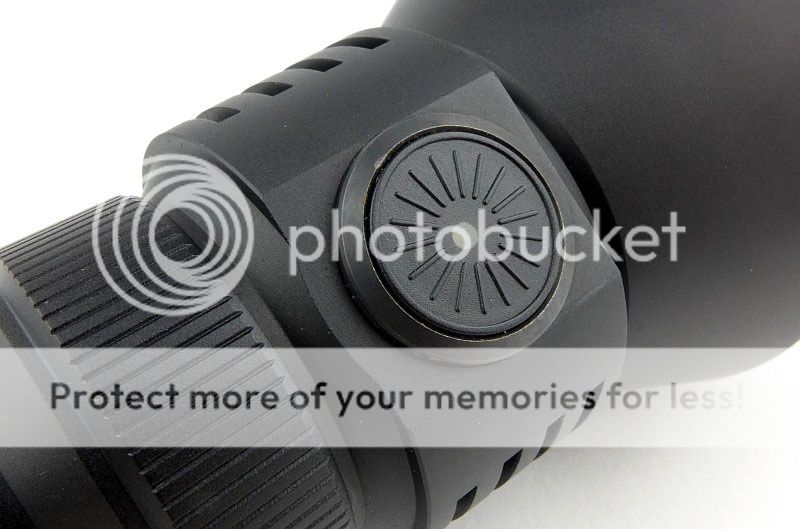
Either side of the side-switch are heat sink fins.
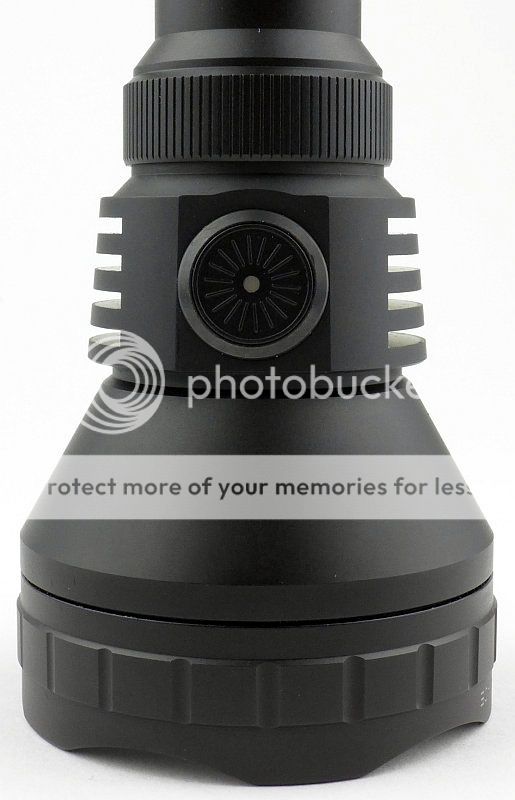
The switch boot is wider than most and the tail-cap has four small raised lugs which allow it to tail-stand (though not very stable).
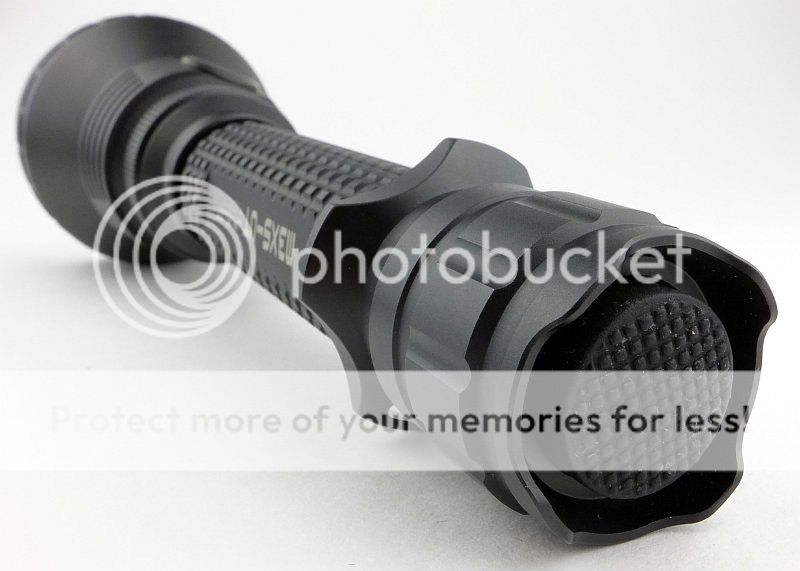
Looking into the tail-cap, the negative terminal is clearly visible, but the contact for the battery tube is only seen as small glimpses. This is due to the design not using a contact point on the end of the tube, but instead fitting into the cone shaped inner edge.
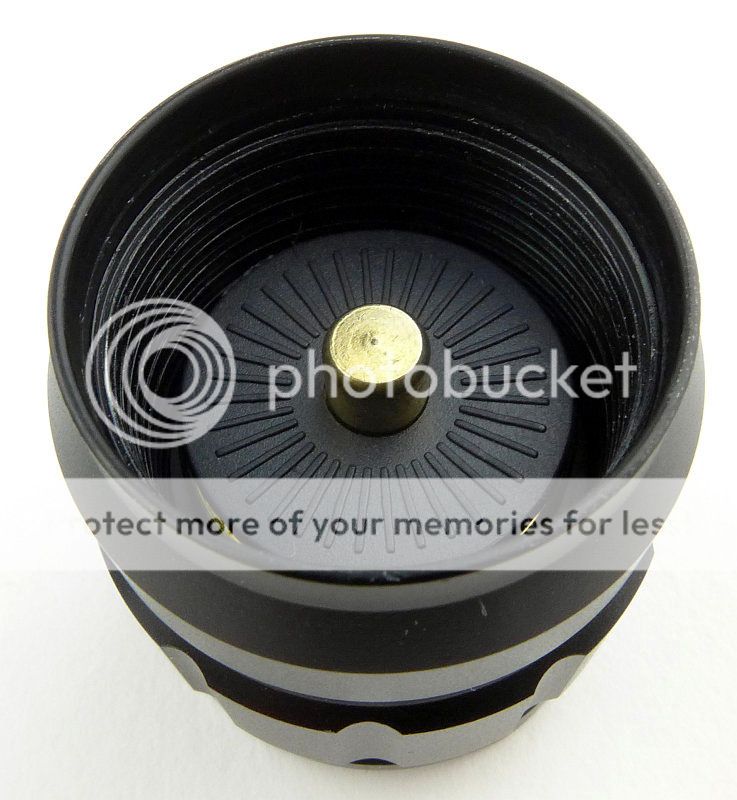
Removing the battery tube completely shows the positive contact in the head as well as the circular battery tube contact.
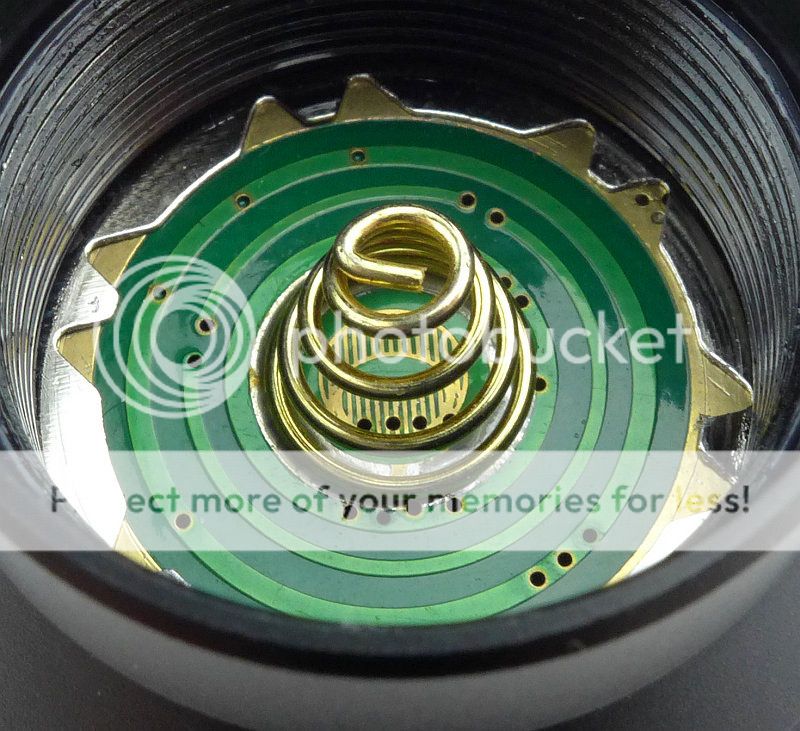
For the tail-cap end of the battery tube, the threads are a square-cut.
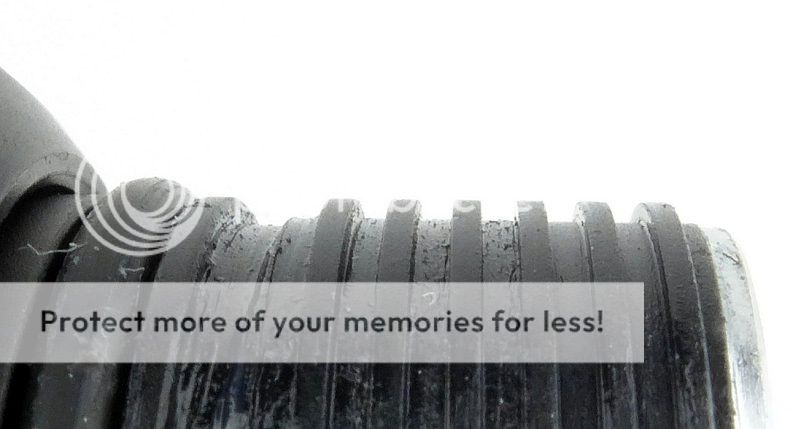
At the head end of the batter tube, the threads are standard and two O-rings are used.
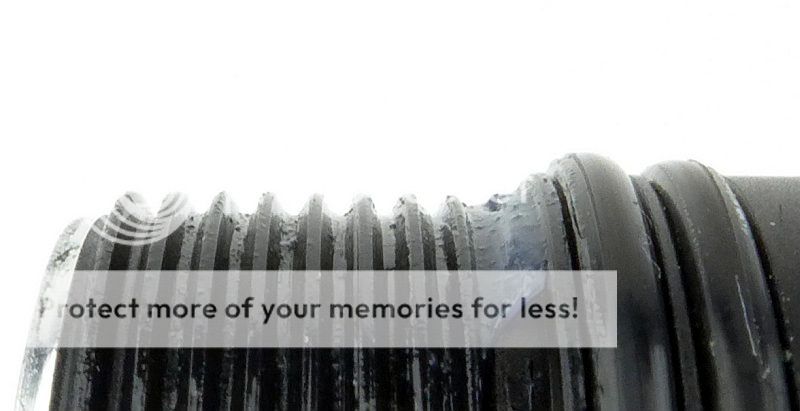
There is just a tiny hint of texturing in the large reflector, and at its heart, a fully exposed XP-L HI LED.
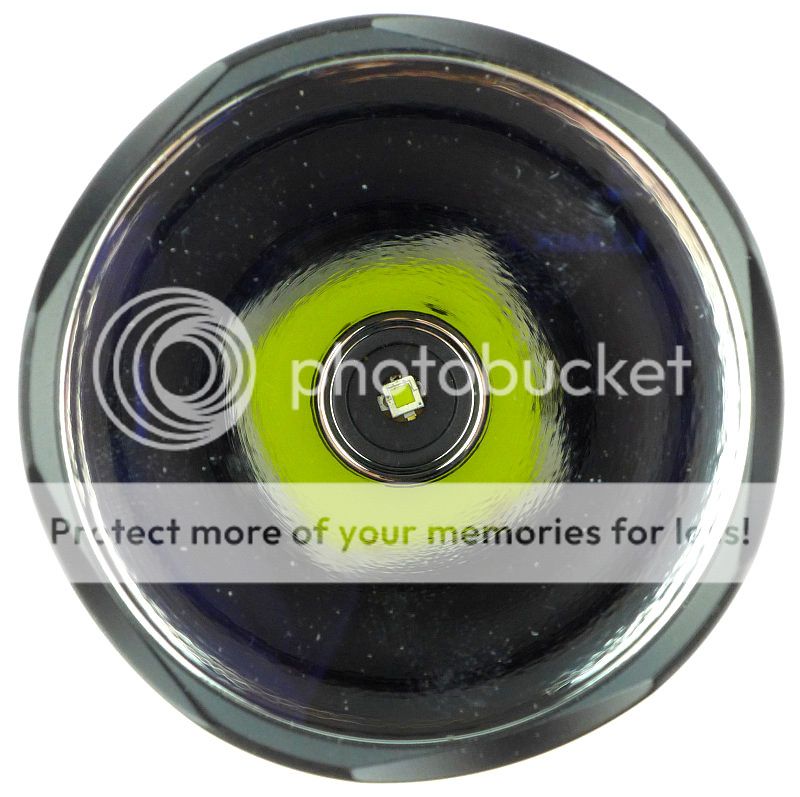
A closer view of the bare phosphor of the XP-L HI.
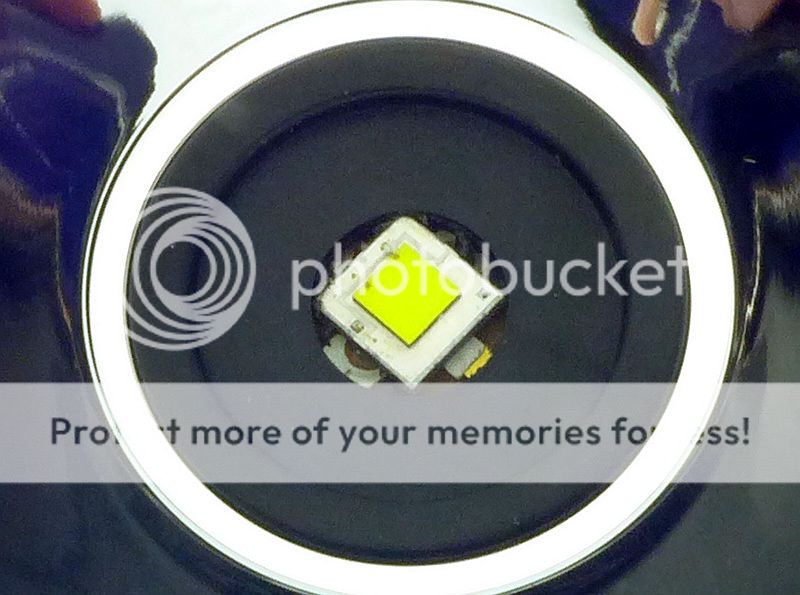
Making comparison to the M2X-UT (using 1x18650), this larger version is clearly longer from the lens to the battery tube due to the inclusion of the side switch and larger heat sink. The non-extended battery tube is also 3xCR123 in length.
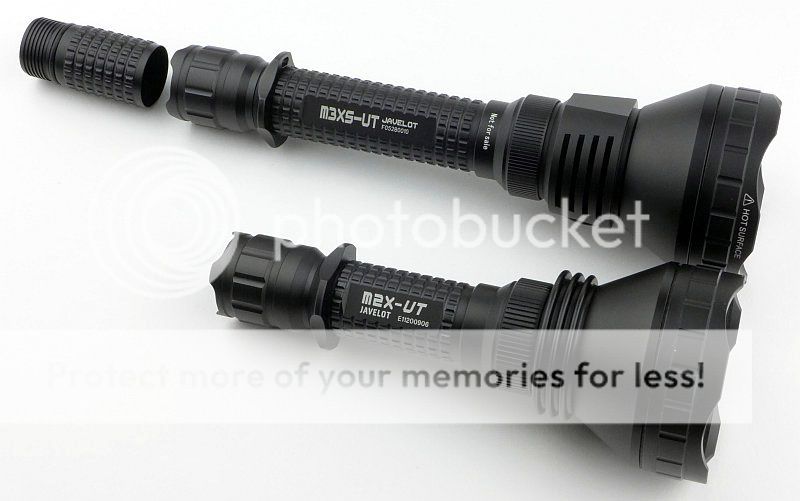
Comparing again with the extension tube fitted.
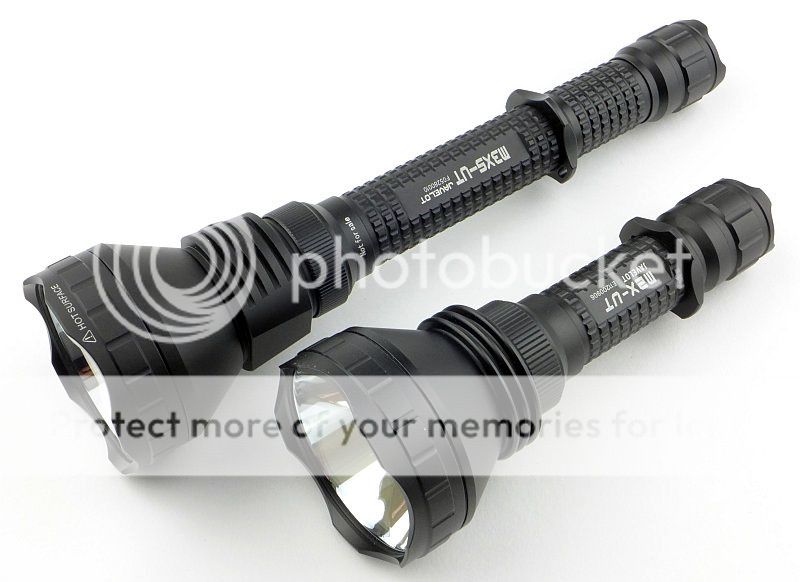
Taking the M3X-UT at its smallest size, it runs on 3xCR123 and has a cell holder to stop any rattle.
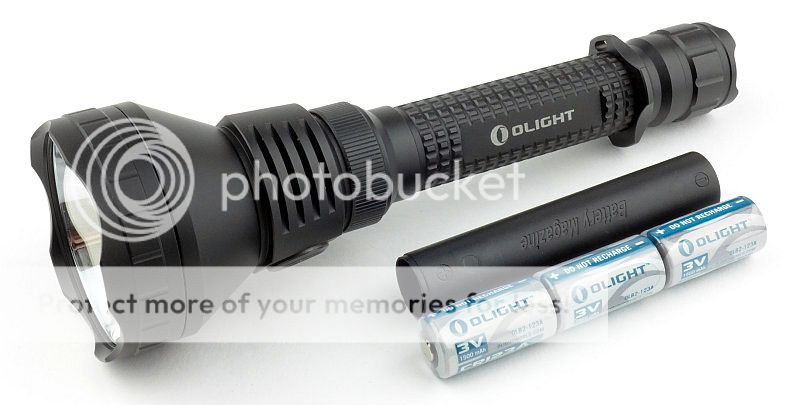
Stepping up to the full length M3XS-UT it runs on 2x18650 or 4xCR123.
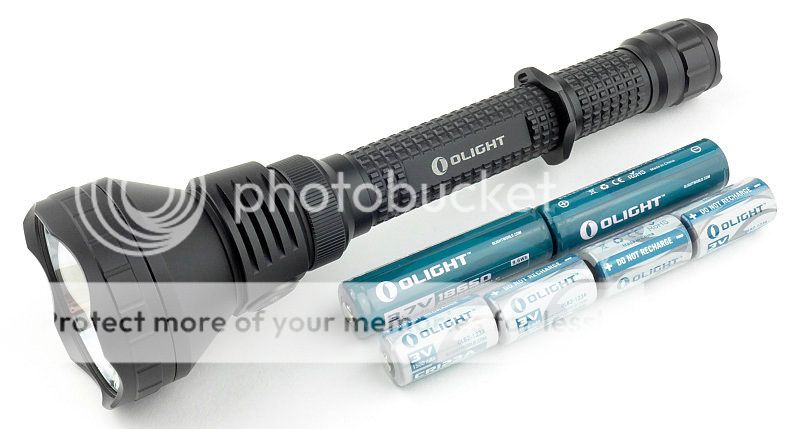
To get the most runtime out of the M3XS-UT use it with the extension tube fitted.
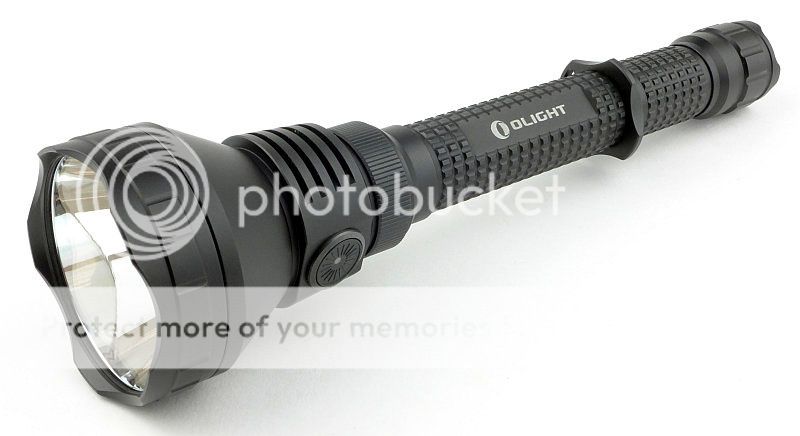
The beam
Please be careful not to judge tint based on images you see on a computer screen. Unless properly calibrated, the screen itself will change the perceived tint.
The indoor beamshot is intended to give an idea of the beam shape/quality rather than tint. All beamshots are taken using daylight white balance. The woodwork (stairs and skirting) are painted Farrow & Ball "Off-White", and the walls are a light sandy colour called 'String' again by Farrow & Ball. I don't actually have a 'white wall' in the house to use for this, and the wife won't have one!
Starting indoors, it is immediately obvious we have a super-high intensity hotspot. In fact what you can see in this photograph is the effect of the hotspot being of such high brightness it is acting as a significant source of light. The edge of the spill is easy to see, but the whole scene is lit behind the spill edge due to the hotspot's light bouncing back.
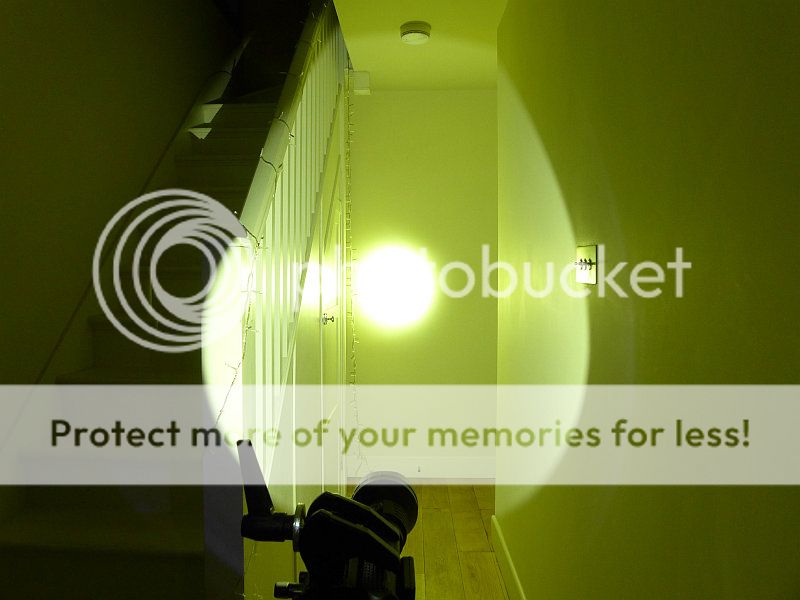
Outdoors the hotspot burns out the centre of the image.
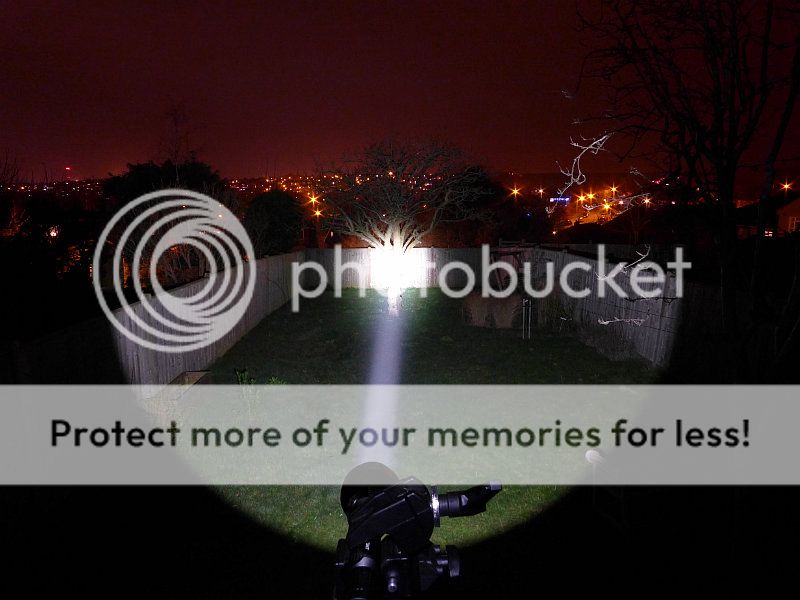
To really appreciate the full power of the M3XS-UT we need a little more range. How about a driving range?
The beam is aimed at a set of four distance markers behind a circular net. The closest marker is 100 yards, with the others set 50 yards apart going up to the furthest at 250 yards.
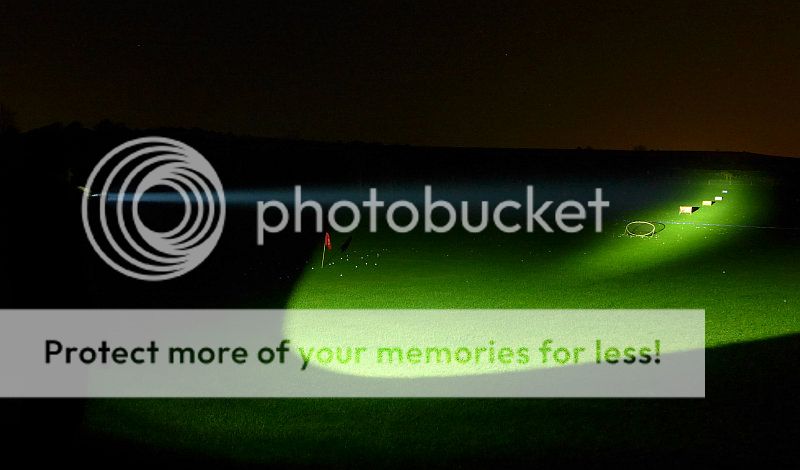
The beam lights well beyond the markers.
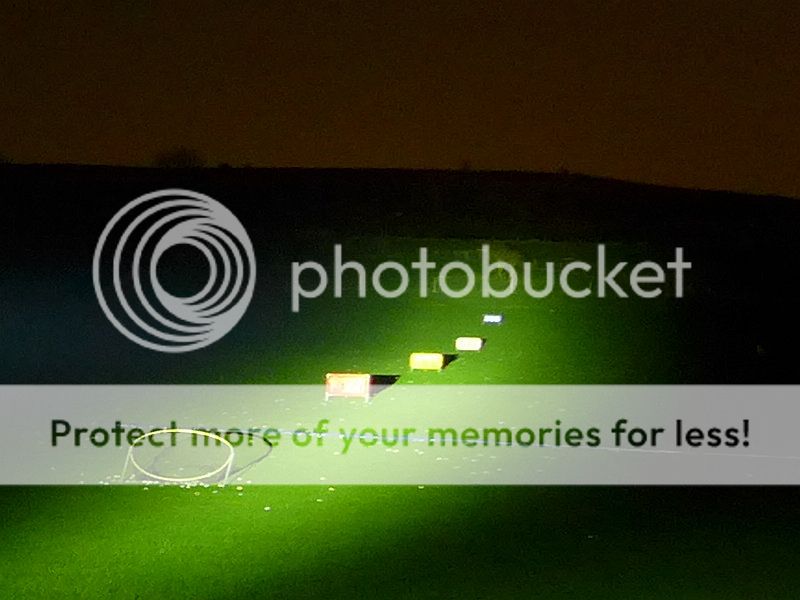
Modes and User Interface:
There are four constant output modes, High, Medium, Low and Moonlight as well as a Strobe mode.
Access to these is via a series of clicks of the forward-click tail-cap switch combined with the side switch.
Turning the M3XS-UT ON with the tail-cap switch, the steady modes are cycled through using the side switch Low -> Medium -> High -> Low etc. The selected mode is memorised for the next time the tail-cap switch is used.
While ON, pressing and holding the side switch turns the output to Strobe.
From OFF, half-pressing or fully pressing the tail-cap switch activates the memorised output level.
From OFF, a rapid double tap of the tail-cap switch activates High. This is not memorised.
From OFF, a rapid triple tap of the tail-cap switch activates Strobe. This is not memorised.
From OFF, holding the side switch while activating the tail-cap switch turns the output to Moonlight. This is not memorised.
Batteries and output:
The Olight M3XS-UT runs on 3/4x CR123 or 2x18650.
To measure actual output, I built an integrating sphere. See here for more detail. The sensor registers visible light only (so Infra-Red and Ultra-Violet will not be measured).
Please note, all quoted lumen figures are from a DIY integrating sphere, and according to ANSI standards. Although every effort is made to give as accurate a result as possible, they should be taken as an estimate only. The results can be used to compare outputs in this review and others I have published.
* Beacon and Strobe output measurements are only estimates as the brief flashes make it difficult to capture the actual output value.
Peak Beam intensity measured 249000lx @1m giving a beam range of 998m.
There is no parasitic drain.
After 8 minutes on High (using either CR123 or 18650) the output makes a controlled reduction to 832lm which is then maintained as a regulated output for as long as the cells can manage.
Running on 2x18650 you have a huge difference in total runtime with the CR123s running into the ANSI cutoff at 35 minutes from turn on, but the 2x18650 (and only 2600mAh cells) gives you up to 1h51m at which point the protection cuts in and the output goes off.
The regulation used in the M3XS-UT means that you get little or no warning of the output cutting out. On 18650 the protection activates, and with CR123 the output plummets once the cells are depleted.
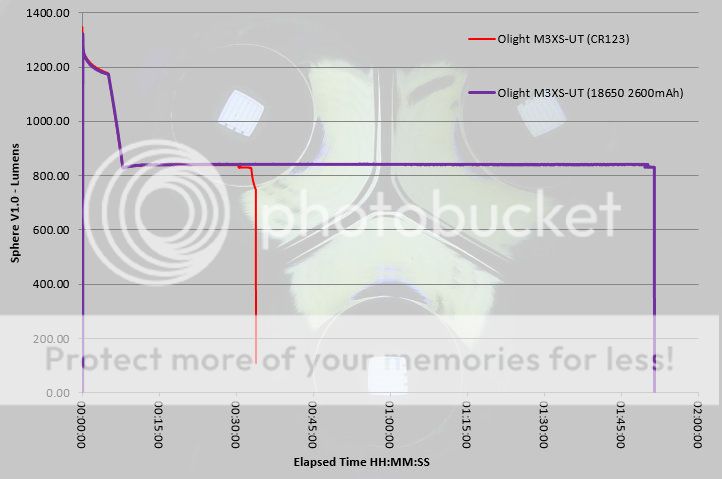
Troubleshooting
This section is included to mention any minor niggles I come across during testing, in case the information helps anyone else.
No issues were encountered during testing.
As per the description of this section, this information is provided in case anyone else finds a similar 'issue' that might be fixed in the same way.
The M3XS-UT Javelot in use
This light is an out-and-out throw monster. Unless the extra 3.5cm is a deal breaker, you will want to use the extension tube for the massive increase in run time and guilt-free rechargeable lumens.
At short ranges the M3XS-UT is too tight a beam for comfortable use. It is great for ceiling bounce, but not when directed towards whatever you are looking at. Of course if you are peering into a deep space, the tight beam works wonders, but for general use this extreme-thrower is not the right choice. What you want this light for is its throw and lightsaber like beam.
Due to the intensity of the beam, if you hold it too near to your line of vision the beam itself can obscure your view of what you are shining it at. It is best to hold the light away from your head to allow you to see further. This varies with atmospheric conditions being far more noticeable when the air is moisture laden.
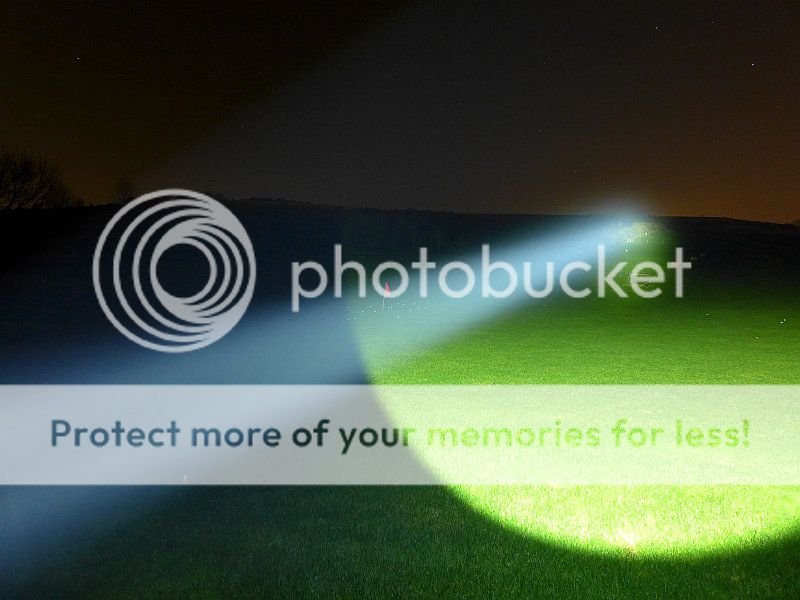
Compared to the smaller M2X-UT (which has very impressive performance – see my review of the M2X-UT for more details), the M3XS-UT steps things up. At 182800 lux@1m the M2X-UT has a beam range of 855m, but with the M3SX-UT this is raised to 249000 lux@1m and a beam range of 998m. A significant jump in beam intensity from the same diameter reflector.
If you are using the momentary output to flash a signal, it is quite easy to activate strobe, and I'd much prefer there to be no strobe at all. In an extreme-range searchlight I see no point in strobe.
Much better is the partly hidden Moonlight mode. In practical terms, due to the highly focussed beam, Moonlight mode is not terribly useful. All you end up seeing is a small bright circle with very dim spill round it. Better than nothing, but this is not a close-range light even with moonlight mode. If only strobe were hidden in this way, then you could easily avoid it.
Handling with the extension fitted is really good. Though the grip ring is now further from the switch, it simply sits between your middle and ring finger, or ring finger and little finger, and gives you plenty of security. I particularly like the machined grip pattern on the battery tube. It is not as abrasive as knurling, but the knobbles give great hold without acting like sandpaper.
The lux figures speak for themselves, and yet the M3XS-UT is not overly large, so you get fantastic throw in a still relatively compact and easy to handle light.
It may not be an all-rounder, but that is not what this light is all about - give it some range and the M3XS-UT truly sings.
Review Summary
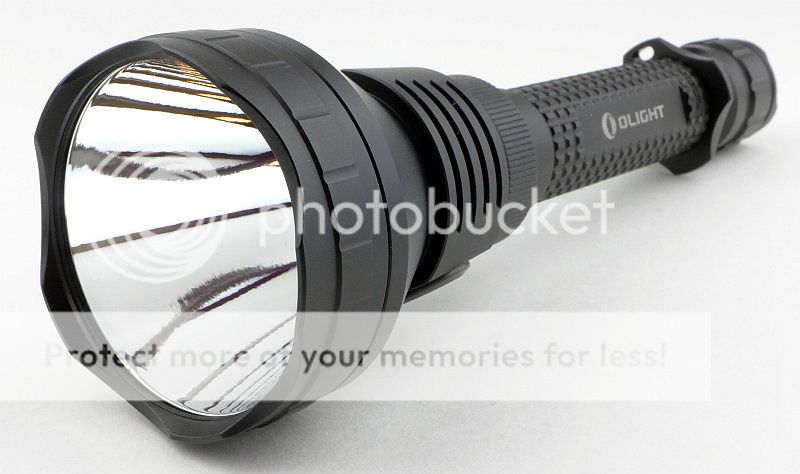
---------------------------------------------------------------------------------------------------------------------
Author's Statement for Transparency and Disclosure
The test sample/s featured in this article have been provided for technical testing and review by the manufacturer. Test samples are retained by the reviewer following publication of the completed review for the purposes of long term testing and product comparisons.
All output figures and test results published in this review are the sole work of the reviewer, and are carried out independently and without bias. Test results are reported as found, with no embellishments or alteration. Though best endeavours are made to maintain the accuracy of test equipment, the accuracy of these results is not guaranteed and is subject to the test equipment functioning correctly.
----------------------------------------------------------------------------------------------------------------------
Author's Statement for Transparency and Disclosure
The test sample/s featured in this article have been provided for technical testing and review by the manufacturer. Test samples are retained by the reviewer following publication of the completed review for the purposes of long term testing and product comparisons.
All output figures and test results published in this review are the sole work of the reviewer, and are carried out independently and without bias. Test results are reported as found, with no embellishments or alteration. Though best endeavours are made to maintain the accuracy of test equipment, the accuracy of these results is not guaranteed and is subject to the test equipment functioning correctly.
----------------------------------------------------------------------------------------------------------------------
Olight have been building up performance levels with the other Javelot models. These Javelots have been getting noticed for their enhanced throw, and then Olight released the M3XS-UT taking performance up another notch. The M3XS-UT is currently the top of performer amongst the Javelots.

Taking a more detailed look:
Like all the Javelots I've tested, the M3XS-UT comes with a plastic carry case rather than a disposable cardboard box.

Inside, the contents are held in place with a foam liner. The empty slot would contain the CR123 holder, but in this case this demonstration light had a set of cells fitted into the light when it arrived.

Included are the M3XS-UT, an extender tube, holster, two O-rings and the instructions. (the CR123 cell holder is already in the light here).

Out of necessity, the M3XS-UT has an open bottom holster.

You have the choice of D-ring or Velcro-closed belt loop.

This is why there is an open bottom in the holster.

This holster can be used with or without the extension tube.

The M3SX-UT has a removable grip ring.

Instead of standard knurling a very effective pattern is machined into the body.

In addition to the tail-cap switch, there is a side-switch for mode selection.

Either side of the side-switch are heat sink fins.

The switch boot is wider than most and the tail-cap has four small raised lugs which allow it to tail-stand (though not very stable).

Looking into the tail-cap, the negative terminal is clearly visible, but the contact for the battery tube is only seen as small glimpses. This is due to the design not using a contact point on the end of the tube, but instead fitting into the cone shaped inner edge.

Removing the battery tube completely shows the positive contact in the head as well as the circular battery tube contact.

For the tail-cap end of the battery tube, the threads are a square-cut.

At the head end of the batter tube, the threads are standard and two O-rings are used.

There is just a tiny hint of texturing in the large reflector, and at its heart, a fully exposed XP-L HI LED.

A closer view of the bare phosphor of the XP-L HI.

Making comparison to the M2X-UT (using 1x18650), this larger version is clearly longer from the lens to the battery tube due to the inclusion of the side switch and larger heat sink. The non-extended battery tube is also 3xCR123 in length.

Comparing again with the extension tube fitted.

Taking the M3X-UT at its smallest size, it runs on 3xCR123 and has a cell holder to stop any rattle.

Stepping up to the full length M3XS-UT it runs on 2x18650 or 4xCR123.

To get the most runtime out of the M3XS-UT use it with the extension tube fitted.

The beam
Please be careful not to judge tint based on images you see on a computer screen. Unless properly calibrated, the screen itself will change the perceived tint.
The indoor beamshot is intended to give an idea of the beam shape/quality rather than tint. All beamshots are taken using daylight white balance. The woodwork (stairs and skirting) are painted Farrow & Ball "Off-White", and the walls are a light sandy colour called 'String' again by Farrow & Ball. I don't actually have a 'white wall' in the house to use for this, and the wife won't have one!
Starting indoors, it is immediately obvious we have a super-high intensity hotspot. In fact what you can see in this photograph is the effect of the hotspot being of such high brightness it is acting as a significant source of light. The edge of the spill is easy to see, but the whole scene is lit behind the spill edge due to the hotspot's light bouncing back.

Outdoors the hotspot burns out the centre of the image.

To really appreciate the full power of the M3XS-UT we need a little more range. How about a driving range?
The beam is aimed at a set of four distance markers behind a circular net. The closest marker is 100 yards, with the others set 50 yards apart going up to the furthest at 250 yards.

The beam lights well beyond the markers.

Modes and User Interface:
There are four constant output modes, High, Medium, Low and Moonlight as well as a Strobe mode.
Access to these is via a series of clicks of the forward-click tail-cap switch combined with the side switch.
Turning the M3XS-UT ON with the tail-cap switch, the steady modes are cycled through using the side switch Low -> Medium -> High -> Low etc. The selected mode is memorised for the next time the tail-cap switch is used.
While ON, pressing and holding the side switch turns the output to Strobe.
From OFF, half-pressing or fully pressing the tail-cap switch activates the memorised output level.
From OFF, a rapid double tap of the tail-cap switch activates High. This is not memorised.
From OFF, a rapid triple tap of the tail-cap switch activates Strobe. This is not memorised.
From OFF, holding the side switch while activating the tail-cap switch turns the output to Moonlight. This is not memorised.
Batteries and output:
The Olight M3XS-UT runs on 3/4x CR123 or 2x18650.
To measure actual output, I built an integrating sphere. See here for more detail. The sensor registers visible light only (so Infra-Red and Ultra-Violet will not be measured).
Please note, all quoted lumen figures are from a DIY integrating sphere, and according to ANSI standards. Although every effort is made to give as accurate a result as possible, they should be taken as an estimate only. The results can be used to compare outputs in this review and others I have published.
| ___________________________________________ | ________________________________ | ________________________________ |
| Olight M3XS-UT Javelot using specified cell | I.S. measured ANSI output Lumens | PWM frequency or Strobe frequency (Hz) |
| ___________________________________________ | ________________________________ | ________________________________ |
| High using 3x Olight CR123 cells | 1243 | 0 |
| Medium using 3x Olight CR123 cells | 678 | 0 |
| Low using 3x Olight CR123 cells | 118 | 0 |
| High using 2x Olight 18650 cells | 1234 | 0 |
| Medium using 2x Olight 18650 cells | 666 | 0 |
| Low using 2x Olight 18650 cells | 116 | 0 |
* Beacon and Strobe output measurements are only estimates as the brief flashes make it difficult to capture the actual output value.
Peak Beam intensity measured 249000lx @1m giving a beam range of 998m.
There is no parasitic drain.
After 8 minutes on High (using either CR123 or 18650) the output makes a controlled reduction to 832lm which is then maintained as a regulated output for as long as the cells can manage.
Running on 2x18650 you have a huge difference in total runtime with the CR123s running into the ANSI cutoff at 35 minutes from turn on, but the 2x18650 (and only 2600mAh cells) gives you up to 1h51m at which point the protection cuts in and the output goes off.
The regulation used in the M3XS-UT means that you get little or no warning of the output cutting out. On 18650 the protection activates, and with CR123 the output plummets once the cells are depleted.

Troubleshooting
This section is included to mention any minor niggles I come across during testing, in case the information helps anyone else.
No issues were encountered during testing.
As per the description of this section, this information is provided in case anyone else finds a similar 'issue' that might be fixed in the same way.
The M3XS-UT Javelot in use
This light is an out-and-out throw monster. Unless the extra 3.5cm is a deal breaker, you will want to use the extension tube for the massive increase in run time and guilt-free rechargeable lumens.
At short ranges the M3XS-UT is too tight a beam for comfortable use. It is great for ceiling bounce, but not when directed towards whatever you are looking at. Of course if you are peering into a deep space, the tight beam works wonders, but for general use this extreme-thrower is not the right choice. What you want this light for is its throw and lightsaber like beam.
Due to the intensity of the beam, if you hold it too near to your line of vision the beam itself can obscure your view of what you are shining it at. It is best to hold the light away from your head to allow you to see further. This varies with atmospheric conditions being far more noticeable when the air is moisture laden.

Compared to the smaller M2X-UT (which has very impressive performance – see my review of the M2X-UT for more details), the M3XS-UT steps things up. At 182800 lux@1m the M2X-UT has a beam range of 855m, but with the M3SX-UT this is raised to 249000 lux@1m and a beam range of 998m. A significant jump in beam intensity from the same diameter reflector.
If you are using the momentary output to flash a signal, it is quite easy to activate strobe, and I'd much prefer there to be no strobe at all. In an extreme-range searchlight I see no point in strobe.
Much better is the partly hidden Moonlight mode. In practical terms, due to the highly focussed beam, Moonlight mode is not terribly useful. All you end up seeing is a small bright circle with very dim spill round it. Better than nothing, but this is not a close-range light even with moonlight mode. If only strobe were hidden in this way, then you could easily avoid it.
Handling with the extension fitted is really good. Though the grip ring is now further from the switch, it simply sits between your middle and ring finger, or ring finger and little finger, and gives you plenty of security. I particularly like the machined grip pattern on the battery tube. It is not as abrasive as knurling, but the knobbles give great hold without acting like sandpaper.
The lux figures speak for themselves, and yet the M3XS-UT is not overly large, so you get fantastic throw in a still relatively compact and easy to handle light.
It may not be an all-rounder, but that is not what this light is all about - give it some range and the M3XS-UT truly sings.
Review Summary
| _______________________________________________ | _______________________________________________ |
| Things I like | What doesn't work so well for me |
| _______________________________________________ | _______________________________________________ |
| Super throw with 249000 lux @1m – 998m beam range | Strobe too easily activated |
| 1200lm output | Not suited to short range use |
| Included extension tube allows for longer runtimes | Regulated output results in shutdown with little warning |
| Holster accommodates extension tube | |
| Bare XP-L HI LED used for highest lux | |
| Relatively compact for its performance |

If you enjoyed my reviews, please remember to 'Like' me on Facebook and follow me on Twitter @Subwoofer_CPF
to get all the latest updates and news.
You can also find exclusive insights on Instagram and Pinterest





to get all the latest updates and news.
You can also find exclusive insights on Instagram and Pinterest

Last edited:

